As Sea Levels Rise, Nantucket Shores Up Crumbling Beaches
Air Date: Week of February 23, 2018
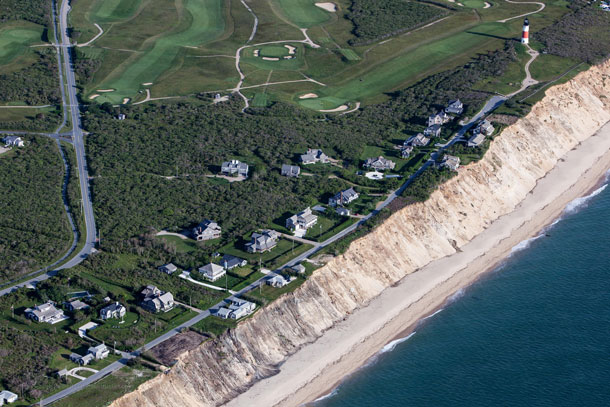
'Sconset’s Baxter Road neighborhood, including Sankaty Head Lighthouse at its northern end. Erosion has been especially rapid in past decades along this stretch of the Nantucket coast. (Photo: 'Sconset Beach Preservation Fund)
30 miles off the coast of New England, Nantucket Island is a historical gem and an upscale haven for summer vacationers. But erosion and rising seas are threatening some of its most expensive real estate. Living on Earth’s Jenni Doering reports that homeowners are funding an extensive engineering project – but some locals worry that it could have ecological consequences.
Transcript
DOERING: Thirty miles off the coast of New England is an island that the National Park Service calls the “finest surviving architectural and environmental example of a late 18th-and early 19th-century New England seaport town.” Back then, Nantucket grew rich on the spoils of the whaling industry. And even after petroleum put that industry out of business, much of the island’s elegant wharf-side architecture remained.
[OCEAN WAVES SFX START FADE IN; GULLS CALLING (link to audio uploaded by Freesound.org user juskiddink)]
DOERING: Today, Nantucket is a popular summer colony, and the historic homes have been joined by newer, but still tasteful, construction – in places no one would have built back in the whaling days. At the east end of the island is Siasconset – locals call it simply, ’Sconset. Its multi-million-dollar cottages have stunning views directly facing the great Atlantic, where it comes ashore in its full ferocity.
[OCEAN WAVES]

A bumper sticker seen on the island. (Photo: Jenni Doering)
DOERING: So the very bluff on which they are built, and the beaches below, are under assault, says Mark Borrelli, a coastal geologist at UMass Boston.
BORRELLI : There’s so much energy at the coast. If you think of a cubic meter of sea water it weighs about one metric ton, so there’s a huge amount of mass in water. Now, you think, on the North Atlantic Coast, a wave will hit a beach every six seconds on average. And it’s relentless.
DOERING: Standing on the beach, facing the open ocean on the Nantucket shore, I could feel this energy as a wave curled over and crashed down.
[OCEAN WAVES CRASH LOUDLY]
DOERING: And these powerful waves are slowly eating away at the island.
BORRELLI : Nantucket and parts are getting smaller...for the most part, yeah, you’re losing land on Nantucket.
DOERING: It’s not just the energy at the coast that’s to blame; rising seas caused by climate change, and the island’s geology, are also part of the problem.
BRACE : We’re very very vulnerable here. We’re not the rocky coast of Canada or Maine or Oregon. We’re sand.
DOERING: Peter Brace is a naturalist. At ’Sconset, that sand holds up dozens of summer homes: big, sturdy cottages, covered in gray cedar shingles that keep out the fierce storms that pummel Nantucket. But Josh Posner, the President of the ’Sconset Beach Preservation Fund, says they’re no match for the erosion that’s creeping closer to their foundations.
POSNER: The edge of the bluff has moved back towards the road that is behind the houses, in a lot of the places 100 feet of the lot has now collapsed so what used to be a 150-foot lot is now 50 foot or even in some cases less.
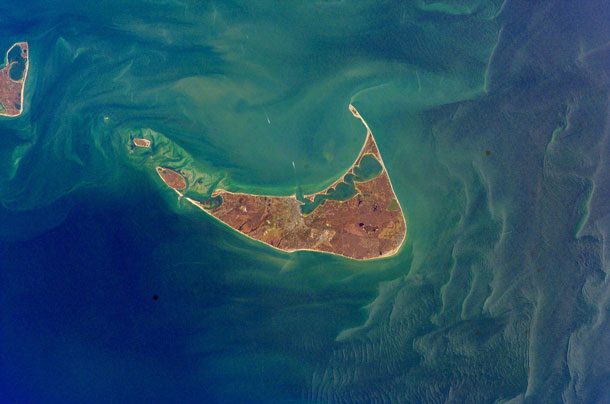
Nantucket is shaped rather like a porkchop, thanks to winds and waves sculpting it over thousands of years. (Photo: NASA Johnson Space Center – Earth Sciences and Image Analysis (NASA-JSC-ES&IA)
DOERING: Posner and his neighbors aren’t just sitting back and waiting for the waves to carry their property out to sea.
POSNER: Where do you make a stand and how do you make a stand, in order to protect what we’ve built and protect our civilization?
DOERING: After trying a few different ways of shoring up the bluff over the years, with limited success, Posner and his deep-pocketed neighbors decided in 2013 to try something on a much larger scale. From the modest cottage she rents at ’Sconset, Marianne Kelley has watched this latest project unfold.
KELLEY: I know they were trying to do it from the base of the bluff, which is where they were doing um, the jute, filling the jute sand bags; I call them sand burritos.
DOERING: They’re actually called geotubes, and indeed they do look a bit like giant burritos! 200 feet long, seven and a half feet tall, and 20 feet wide, the geotubes line the bluff for 1000 feet and are stacked at an angle, four high. Marianne Kelley invites me to her front-row-seat view from the edge of her backyard – the very edge – just seventeen feet from her house.
[SOUND OF WAVES]
KELLEY: Yeah, does this scare you?
DOERING ON TAPE: Well, it it does feel like on the edge.
KELLEY: ’Cause some people can’t, they can’t go very close. I’m used to it now.
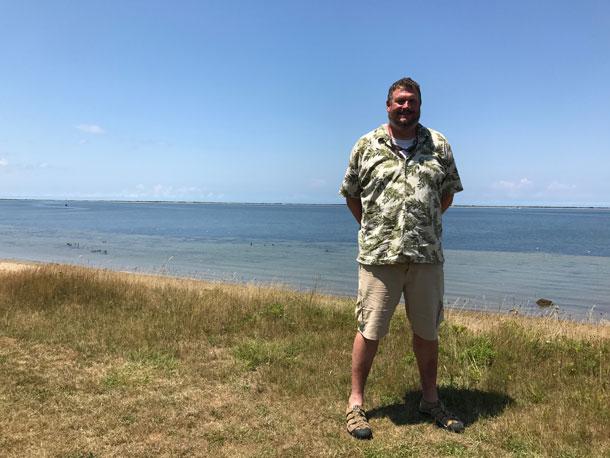
Peter Brace is a Nantucket naturalist who leads natural history walks around the island. (Photo: Jenni Doering)
DOERING: From Kelley’s backyard, I can’t actually see the geotubes themselves: they’re covered with sand, to return the engineered bluff to a state as close to natural as possible. Far below, the waves crash onto a narrow beach.
[MORE WAVES]
DOERING: The geotubes that defy the force of those waves are designed to stay firmly put. But the sand that covers them is dynamic. Again, Peter Brace.
BRACE: Waves that are breaking on the shore are taking sand into the water, and a current carries the sands, the sediments, along the shore in one direction or another.
DOERING ON TAPE: Nantucket itself is -- it is kind of shaped like a horseshoe, or maybe like a boomerang.
BRACE: Or a porkchop.
DOERING ON TAPE: Or a porkchop! That’s a great way of putting it.
DOERING: In fact, (perhaps like your dinner), the island came straight out of a gigantic freezer: a massive ice sheet that covered much of North America 25,000 years ago.
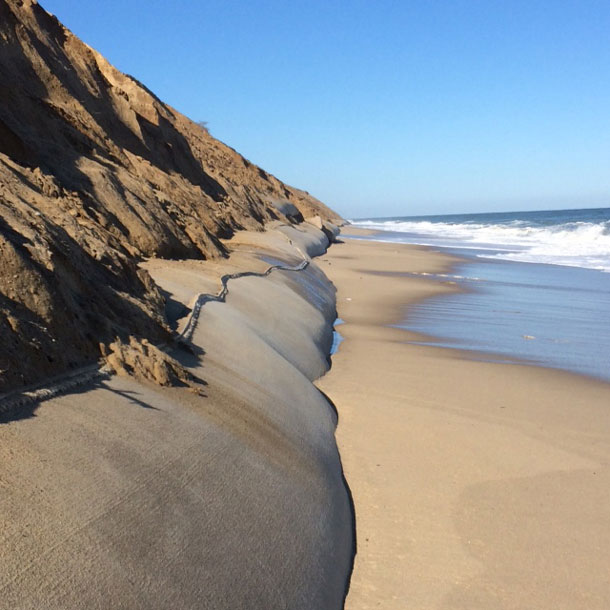
Winter Storm Jonas in January 2016 brought crashing waves that uncovered the geotubes, before more sand was added back on top. (Photo: 'Sconset Beach Preservation Fund)
BRACE: The Laurentide Ice Sheet covered all of Canada at one time, and then covered the top northern one-third of the U.S. almost out to the west coast.
DOERING: And Brace says this gargantuan block of ice was a powerful geologic force that shaped the land as it moved.
BRACE: You have to kind of look around you and see what you see here, didn’t exist. It didn’t exist yet. It was just, it was the coastal plain. And the material got pushed here.
DOERING: What got pushed there was a lot of sand – and Emily Molden says for thousands of years, it’s been in motion, driven by the forces that the geotubes are designed to resist.
MOLDEN: And that sand doesn’t just disappear. It’s going somewhere. It has a destination. So it’s serving as a sediment source to other beaches, to other sandbars, other shoals.
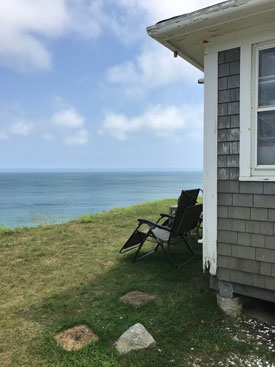
Marianne Kelley’s ’Sconset cottage has a great view – but not much backyard before the drop-off. (Photo: Jenni Doering)
DOERING: Molden’s the resource ecologist for the Nantucket Land Council, a land trust and watchdog group.
MOLDEN: We are especially concerned about the geotubes constructed in ’Sconset because that’s really a ground zero for erosion on the island. By preventing that sediment from eroding out of the bluff, you’re starving those down-gradient areas and systems from sand that they would naturally be receiving.
DOERING: That’s one reason why the geotubes must be covered with sand at all times – so that nature still has something to work with. Josh Posner again.
POSNER: We add on top of our geotubes the amount of sand that historically has washed away in the natural erosion process. And so, the system is covered with sand almost all of the time.
DOERING: But only almost all the time, because in the fiercest storms like powerful Nor’easters, the sand covering the geotubes gets washed away. That happened just this January 2018, when a massive Nor’easter brought record high tides and flooding to Nantucket and the rest of New England. So after such a storm, the ’Sconset Beach Preservation Fund brings in the dump trucks, carting material from sand pits elsewhere on the island.

Josh Posner in his Cambridge, Massachusetts home. (Photo: Jenni Doering)
That effort, like the geotubes, is funded by the homeowners at ’Sconset Bluff. Emily Molden says it’s good that sand covers the geotubes most of the time – but she doubts it can last.
MOLDEN: That sand is becoming more and more expensive. And the greater the extent of a structure like the geotubes, the more sand is necessary. Now, I think that you’re looking at a structure that has a pretty long lifespan, probably decades. So it’s just hard to say going forward whether that interest and funding will continue.
DOERING: Re-covering the geotubes might need to happen even more frequently in the near future, as climate change brings rising seas and nastier storms. Since Nantucket is a ways offshore, storms are already quite fierce in the wintertime. Unlike many of her neighbors who only summer on Nantucket, Marianne Kelley lives in her small cottage year-round.
KELLEY: I’ve been here in the winter and I’ve been through a lot of the storms and I’ve seen, you know, glass fall off our shelves, our house shakes in the heavy winds -- we get over 100 miles an hour here. I always joke around that I’d bungee cord myself to the nearest telephone pole in a storm, but in really big storms I don’t stay here.
DOERING: Some of her neighbors joke about the situation, too – houses here have names like “House of Cards” and “Slip-Slide-N-Away.” Down the road from Kelley, neighbor Loretta Yoder’s backyard is really slip-slidin’ away – often without warning.
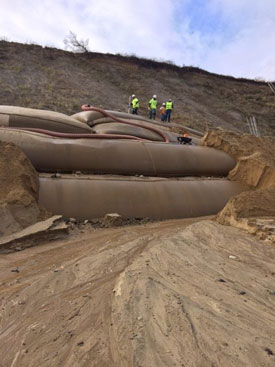
The geotubes during installation. (Photo: ‘Sconset Beach Preservation Fund)
YODER: I went for a walk on a sunny day like this and when I came back a chunk – a one- or two-foot chunk from the edge – had fallen down.
DOERING: Usually, nature sculpts more gradually, and Yoder has spent years observing this slow process.
YODER: The bluff wants to find what they call its comfort angle of repose, which is an angle where plants and dirt can hold on. With a bluff, with a dirt bluff that’s not planted, you’re going to always have some attrition.
[SOUNDS OF WIND; RAIN & TRICKLING WATER; WAVES]
The wind takes it away, the rain makes little rivers. And if the waves come in and eats away at the toe, that goes back and then the top dribbles down to match that.
[WAVES CRASH LOUDLY]
DOERING: After that chunk of earth fell away from her backyard, Yoder and her partner decided to move their house thirty-four feet back from the edge.
YODER: It was getting to the point where… it just felt like if we wanted to stay in a place and that it was secure we needed to do it.

In the summertime, Loretta Yoder throws open the garage door of her ‘Sconset home and paints in her makeshift studio and gallery. Geotubes don’t yet line the bluff below her home, which is threatened by erosion, but a proposal to expand the existing project would extend them to below her property. (Photo: Jenni Doering)
DOERING: But at some point, you just run out of room. And Yoder’s part of the bluff isn’t shielded by geotubes. The ’Sconset Beach Preservation Fund wants to change that.
Josh Posner took the first step in January 2018 by submitting a proposal to expand the geotubes from the current 1000 feet to nearly 4000. He says it’s not just an engineering challenge – it’s also a moral issue.
POSNER: You know, our job as people is to use common sense and judgement about what makes sense and what doesn’t, and where it makes sense and where it doesn’t. So, I know there’s people who feel that the only responsible thing to do in our situation is to abandon our homes and let erosion take its natural course. I don’t happen to agree with that.
DOERING: That choice about whether to engineer solutions to erosion and sea level rise – or, to retreat -- now faces coastal communities everywhere.
[DISTANT WAVES]
DOERING: Sea levels are predicted to rise two to seven feet in this century. And remember: this island is nothing more than loose, sandy material; no match for powerful waves and rising seas, says Nantucket ecologist Peter Brace.
BRACE: We’re right where it’s going to happen. We’re gonna go underwater before a lot of the coastline.
DOERING: In the meantime, Loretta Yoder keeps a close eye on the bluff edge in her backyard.
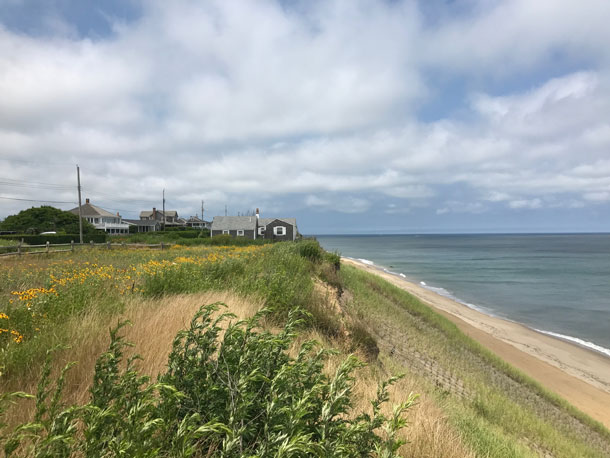
The bluff has been replanted with native grasses to help hold the eroding sand and soil in place. (Photo: Jenni Doering)
YODER: We put a little log up on the edge and we wait and see how long it takes for that little 5-inch piece of wood to not have any support under it and fall down.
DOERING: And what works or doesn’t work to hold back the sea on this tiny island may hold valuable lessons for coastal communities everywhere. In the meantime, the sea that’s sculpted Nantucket over thousands of years continues to push and pull sand -- shaping the shore, and the lives of the people on this little pork chop of an island.
[SOUNDS OF WAVES]
DOERING: And Jaime, I had a lot of help with this story! – I owe thanks to Living on Earth’s Matt Hoisch and Rebecca Redelmeier.
KAISER: Yes our whole team was on Nantucket – we had a great time and next week, I’ll be reporting on its crab populations.
Links
Living on Earth wants to hear from you!
Living on Earth
62 Calef Highway, Suite 212
Lee, NH 03861
Telephone: 617-287-4121
E-mail: comments@loe.org
Newsletter [Click here]
Donate to Living on Earth!
Living on Earth is an independent media program and relies entirely on contributions from listeners and institutions supporting public service. Please donate now to preserve an independent environmental voice.
NewsletterLiving on Earth offers a weekly delivery of the show's rundown to your mailbox. Sign up for our newsletter today!
 Sailors For The Sea: Be the change you want to sea.
Sailors For The Sea: Be the change you want to sea.
 The Grantham Foundation for the Protection of the Environment: Committed to protecting and improving the health of the global environment.
The Grantham Foundation for the Protection of the Environment: Committed to protecting and improving the health of the global environment.
 Contribute to Living on Earth and receive, as our gift to you, an archival print of one of Mark Seth Lender's extraordinary wildlife photographs. Follow the link to see Mark's current collection of photographs.
Contribute to Living on Earth and receive, as our gift to you, an archival print of one of Mark Seth Lender's extraordinary wildlife photographs. Follow the link to see Mark's current collection of photographs.
 Buy a signed copy of Mark Seth Lender's book Smeagull the Seagull & support Living on Earth
Buy a signed copy of Mark Seth Lender's book Smeagull the Seagull & support Living on Earth

